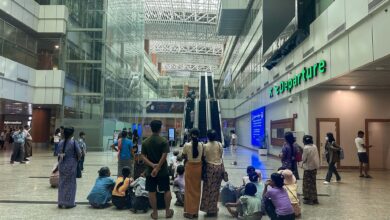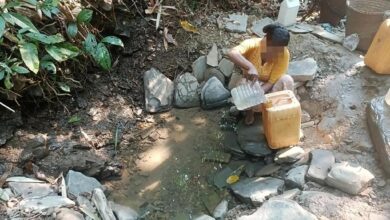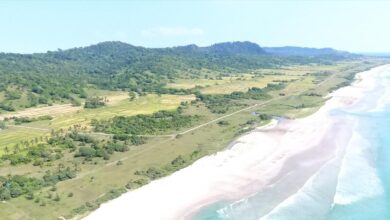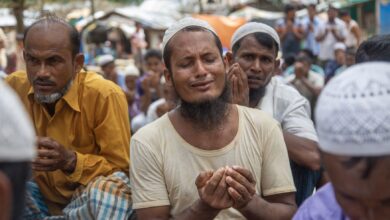
Venerable Yazina’s robes did not protect him when the army trucks appeared. Despite his status as a member of Myanmar’s revered Buddhist monkhood, he was fair game for the soldiers who opened fire the moment they arrived on the scene.
The teaching monk from Mandalay’s New Masoeyin Monastery was among those who were hit that day. But it wasn’t a bullet that took him down—it was one of the vehicles that had sped into the crowd as protesters scattered in an effort to escape.
“We had just left the monastery when they arrived and started shooting,” he recalled. “Everyone was running in a panic. I tried to hop onto a motorcycle to get away, but that was when they struck me with a car.”
Knocked to the ground, Ven. Yazina was helpless as three soldiers began beating his shaved head again and again.
Now in the junta’s custody, the monk was forcibly disrobed and dragged off to the notorious interrogation centre at Mandalay Palace to be tortured as just another layperson who had dared to challenge the military’s hold on power.
By May 28, the day of his arrest, Ven. Yazina had been protesting against the coup for more than three months. Hundreds had already been killed in crackdowns around the country, and thousands more arrested. Many of those who found themselves behind bars did not come out alive.
He did not expect mercy. He knew that even monks were routinely subjected to unimaginable cruelty at the hands of regime forces.
For the next six days, from 9am to 3pm, two interrogators took turns inflicting as much suffering as they could, not caring if they killed him in the process. He and the other detainees captured at the same time were beaten almost constantly as they were questioned about their participation in the protests.
When the junta’s henchmen tired of hitting the prisoners with truncheons, they would force them to assume painful and humiliating positions in a further effort to break their spirits.
“First they made me squat down. Then they told me to put my hands on my head and hop around like a frog. After that, I had to kneel down on the hot pavement with my hands still on my head,” he said.
“The pain was unbearable. They made me ‘walk’ like this back to my cell. It took about 30 minutes, and if I slowed down, they would hit me again from behind.”
But at some point, he became defiant, telling his tormentors that they could beat him all they liked, because he could no longer move on his shattered knees.
“That’s when I told them that I wanted a humane government. At this, the officer just pointed his gun at me and said, ‘How dare you?’”
They made me ‘walk’ like this back to my cell. It took about 30 minutes, and if I slowed down, they would hit me again from behind

Saffron scars
In a country where monks are held in the highest esteem, this treatment seems almost unthinkable. And yet none of this is new to the people of Myanmar, who have grown used to seeing monks abused by their ostensibly Buddhist rulers.
Ven. Yazina, who was only recently released from prison, is just one of the latest victims of the regime’s assaults on members of the monastic order.
At least 23 monks are known to be in the regime’s custody, some of whom have been severely tortured, according to accounts from released prisoners.
On March 11, Ven. Eainaka, better known as Yaypu Sayadaw, was forcibly disrobed after being arrested by junta forces sent to crush a protest in Mogok. A month later, he was found guilty of incitement under Section 505b of the Penal Code and sentenced to three years in prison.
More recently, on July 4, regime forces raided a monastery in The Gone, a village near the town of Hopin in Kachin State’s Mohnyin Township, tied up its abbot, and beat him—possibly because he was seen with protesting villagers in a photo taken by a junta informant.
It was nearly 14 years ago, during the Saffron Revolution, that Myanmar’s military leaders demonstrated how far they were willing to go to neutralize monks as a political force. To suppress that monk-led uprising against military rule, they rounded up at least 300 monks and shut down 61 monasteries.
“Back in 2007, we went around the city chanting the Metta Sutta, the Discourse on Loving-Kindness, and they opened fire on us,” said Ven. Min Thone Nya, one of those who took part in the movement to overthrow the former dictatorship.
“Then they raided our monasteries and arrested us like criminals. They didn’t care if they hurt or even killed us,” he recalled.
Some of the monks died of their injuries after their release from prison.
Many who were eventually freed were locked out of their monasteries, which were now firmly under the junta’s control. Left homeless and bearing the mental and physical scars of countless beatings and other torture, they struggled to survive in a country where they were once treated with reverence.
One of the most prominent leaders of the Saffron Revolution was Ven. Gambira, who was not released until 2012. By that time, he was so traumatized by his ordeal that he suffered from debilitating headaches and mental illness.
“His head trauma would give him headaches so intense that someone had to press down on his head from the side” to relieve the pain, said Ven. Min Thone Nya.
Still persecuted in Myanmar, and in desperate need of medical assistance to deal with his head injuries, he went to Chiang Mai, Thailand, to undergo brain surgery. Eventually, he was granted asylum in Australia.

Feared monks
One of the monks currently in prison for opposing the coup is Ven. Sandar Thiri, who also took part in the Saffron Revolution. He was arrested on March 13, accused of being a leader of the Civil Disobedience Movement, and now faces up to three years in prison on charges of incitement.
Speaking to Myanmar Now just days before his arrest, he was unequivocal in his opposition to the current regime, which stole power from an elected civilian government.
“We don’t need a dictator in our country. We don’t want a dictator in our country. We will stand with the people until the dictatorship is no more,” he said.
Some monks were so feared by the junta that they were arrested on the day of the coup.
We will stand with the people until the dictatorship is no more
Another Saffron Revolution leader, Ven. Thawbita, was taken away from his monastery in Patheingyi, east of Mandalay, in handcuffs on the morning of February 1. He had been facing charges of defaming coup leader Min Aung Hlaing (for allegedly likening him to a cow on social media) at the time of his arrest.
Ven. Pyinya Thiha, the head monk of Shwe Nya Wah monastery in Yangon, met a similar fate. On January 31, the day before his arrest, he earned the ire of the generals when he said, “Whoever creates ripples in the peace of the nation will go down in history as the nation’s worst criminal.”
According to Ven. Min Thone Nya, the fact that the junta went after senior monks right from the start proves that the regime has no respect for the religion that it claims to defend.
“If they really wanted to protect ‘our race and religion’, they wouldn’t arrest respected monks for no reason like this,” he said.
Ven. Yazina agreed that military leaders’ displays of piety were completely insincere and self-serving.
“They use religion when they want something. When they no longer need it, they start terrorizing monks in the streets. They won’t hesitate to shoot, or even kill, us, even though we’re monks,” he said.

Meanwhile, monks who have damaged the reputation of Buddhism, such as those associated with the notorious Patriotic Association of Myanmar (better known by its Burmese acronym Ma Ba Tha), continue to enjoy the favour of the generals.
Although Wirathu, the Ma Ba Tha monk dubbed “The Face of Buddhist Terror” by Time magazine, remains in prison after turning himself in to face sedition charges days before last year’s election, this is seen by some as a measure to protect him so that he can be used to create future mischief.
They use religion when they want something. When they no longer need it, they start terrorizing monks in the streets
“Someone like Wirathu has a high risk of being assassinated if he is outside,” political analyst Than Soe Naing told Myanmar Now recently. “If that happened, they would lose someone who can create great propaganda. So I think they’re waiting for the perfect time to release him.”
More troubling, even prominent monks who once preached political reform, such as the highly respected Ven. Nyanissara, or Sitagu Sayadaw, have been pulled into the regime’s orbit, undermining faith in the country’s spiritual leaders.
All of this has added urgency to calls to defeat the regime and end its corrupting influence, according to Ven. Min Thone Nya.
“We must overthrow this dictatorship at all costs. If we fail, it will be the end of Buddhism as we know it. If they keep oppressing monks who spread the truth of the Dhamma, all that will be left are the dishonoured ones,” he said.



